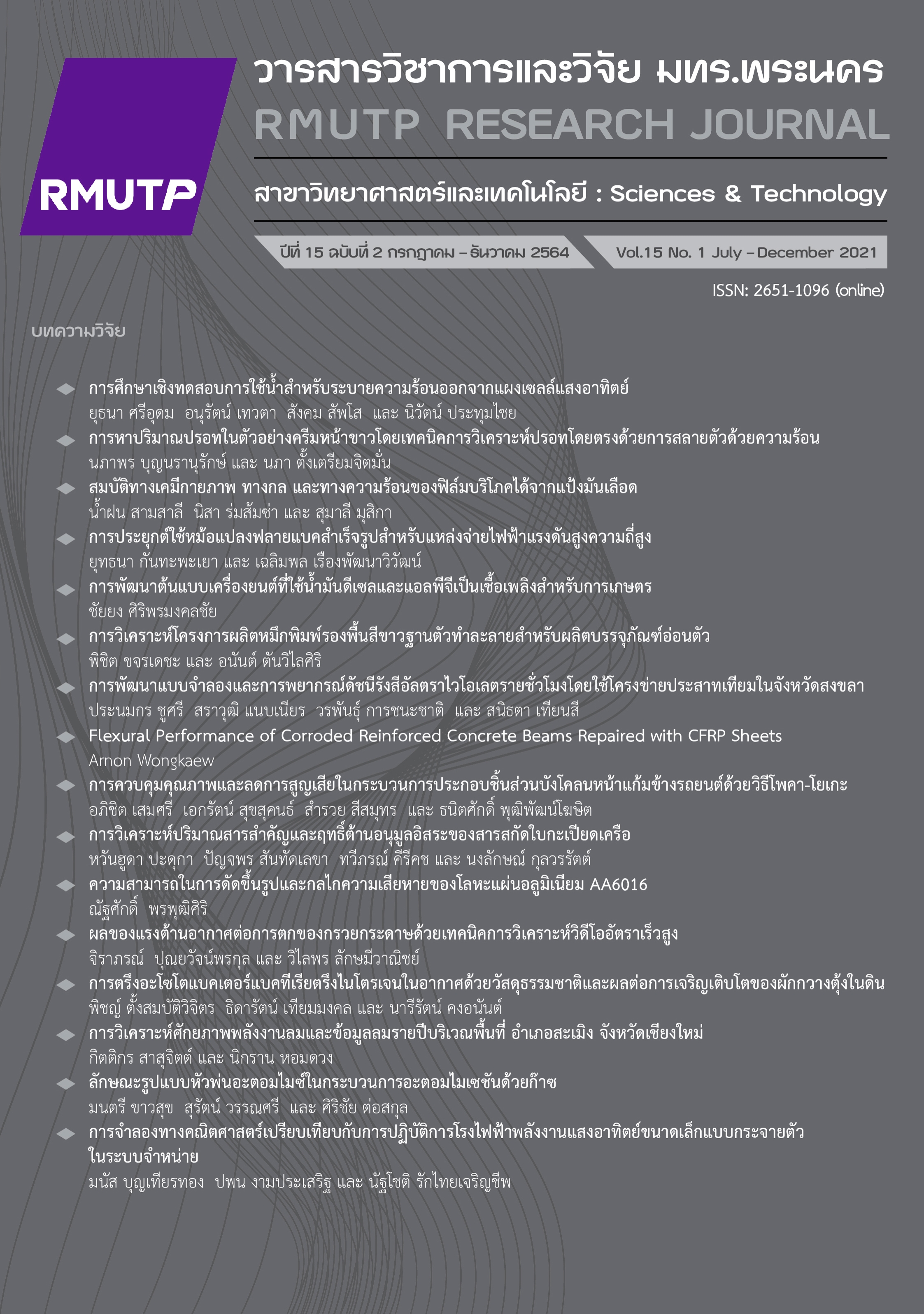การหาปริมาณปรอทในตัวอย่างครีมหน้าขาวโดยเทคนิคการวิเคราะห์ปรอทโดยตรงด้วยการสลายตัวด้วยความร้อน
Main Article Content
บทคัดย่อ
งานวิจัยนี้มีวัตถุประสงค์เพื่อนำเสนอเทคนิคการวิเคราะห์ปรอทโดยตรงด้วยการสลายตัวด้วยความร้อน เทคนิคนี้จัดเป็นเทคนิคที่มีประสิทธิภาพในการหาปริมาณปรอทในตัวอย่างครีมหน้าขาว โดยที่สามารถชั่งตัวอย่างครีมเข้าเครื่องวิเคราะห์ได้โดยไม่ต้องมีการเตรียมตัวอย่าง เป็นการลดมลพิษจากของเสียที่ใช้ในการเตรียมตัวอย่าง รวมทั้งประหยัดเวลาและพลังงานที่ใช้ในการย่อยตัวอย่างอีกด้วย กราฟมาตรฐานที่ใช้พล็อตระหว่างค่าการดูดกลืนแสงของปรอทในรูปความสูงพีคและน้ำหนักของสารมาตรฐานปรอทช่วง 0.1-10 นาโนกรัม กราฟที่ได้มีความสัมพันธ์เป็นเส้นตรงดังสมการ y=2.003x10-2X– 5.14x10-4 มีค่าสัมประสิทธิ์การตัดสินใจ (R2) 0.9991 ความเที่ยงของการวิเคราะห์แสดงในเทอม Repeatability มีค่าร้อยละ 14 และ 5.9 rsd (n=3) ที่ 1.2 และ 868 ไมโครกรัมต่อกิโลกรัม ตามลำดับ ค่าร้อยละการได้กลับคืนอยู่ระหว่างร้อยละ 88-110 ค่าขีดจํากัดการตรวจวัด (LOD) เท่ากับ 0.1 ไมโครกรัมต่อกิโลกรัม (3sd/m, n=10) ปริมาณปรอทที่ตรวจพบในตัวอย่างครีมหน้าขาว 12 ตัวอย่างที่จำหน่ายใน จ.ชลบุรี ในช่วงปี พ.ศ. 2562 พบว่ามีสองตัวอย่างที่เกินเกณฑ์มาตรฐานที่อนุญาตให้มีในเครื่องสำอางไปมาก นอกนั้นอยู่ในเกณฑ์มาตรฐานปลอดภัยต่อผู้ใช้ตามประกาศกระทรวงสาธารณสุข
Article Details

This work is licensed under a Creative Commons Attribution-NonCommercial-NoDerivatives 4.0 International License.
ลิขสิทธ์ ของมหาวิทยาลัยเทคโนโลยีราชมงคลพระนครReferences
R. D. Barr, B. A. Woodger and P. H. Rees, “Levels of mercury in urine correlated with the use of skin lightening creams,” The American Journal of Clinical Pathology, vol. 59, pp. 36-40, Feb. 1973.
C. C. Sun, “Allergic contact dermatitis of the face from contact with nickel and ammoniated mercury in spectacle frames and skin-lightening creams,” Contact Dermatitis, vol. 17, pp. 306–309, Jul. 1987.
M. M. Weldon, M. S. Smolinski, A. Maroufi and B. W. Hasty, “Mercury poisoning associated with a Mexican beauty cream,” The Western Journal of Medicine, vol. 173, no. 1, pp. 15-18, Jul. 2000.
T. Y. Chan, “Inorganic mercury poisoning associated with skin-lightening cosmetic products,” Clinical Toxicology, vol. 49, no. 10, pp. 886-891, Sep. 2011.
A. Boonprachom, N. Yukittichai, N. Ekkabut, N. Pongnimitprasert and N. Nuntharatanapong, “Investigation of ammoniated mercury and hydroquinone in whitening creams distributed in amphur muangnakhon pathom province,” Thai Bulletin of Pharmaceutical Sciences, vol. 8, no. 1, pp. 1-8, Jan. 2013.
P. Kongseree. (2015, Mar 27). Mercury Test Kit-Cosmetics, Department of Chemistry Faculty of Science Mahidol University. [Online]. Available:https://old.mahidol.ac
.th/th/latest_news58/DMSc-Award.html
S. S. Agrawal and M. Mazhar, “Adulteration of mercury in skin whitening creams – A nephrotoxic agent,” Current Medicine Research and Practice, vol. 5, pp. 172-175, Aug. 2015.
Y. B. Ho, N. H. Abdullah, H. Hamsan and E. S. S. Tan, “Mercury contamination in facial skin lightening creams and its health risks to user,” Regulatory Toxicology and Pharmacology, vol. 88, pp. 72-76, May 2017.
C. P. Peregrino, M. V. Moreno, S. V. Miranda, A. D. Rubio and L. O. Leal, “Mercury Levels in Locally Manufactured Mexican Skin-Lightening Creams,” International Journal of Environmental Research and Public Health, vol. 8, no. 6, pp. 2516-2523, Jun. 2011.
S. S. Agrawal and P. Sharma, “Current status of mercury level in skin whitening creams,” Current Medicine Research and Practice, vol. 7, no. 2, pp. 47-50, Apr. 2017.
S. Y. Ng, F. Dewi, J. Wang, L. P. Sim, R. Y. C. Shin, and T. K. Lee, “Development of a cosmetic cream certified reference material: Certification of lead, mercury and arsenic mass fractions in cosmetic cream,” International Journal of Mass Spectrometry, vol. 389, pp. 59-65, Oct. 2015.
J. V. Cizdziel and S. Gerstenberger, “Determination of total mercury in human hair and animal fur by combustion atomic absorption spectrometry,” Talanta, vol. 64, pp. 918-921, Jun. 2004.
D. Saniewsk and M. Bełdowska, “Mercury fractionation in soil and sediment samples using thermo-desorption method,” Talanta, vol. 168, pp. 152–161, Mar. 2017.
A. Luippold and M. S. Gustin, “Mercury concentrations in wet and dry cat and dog food,” Animal Feed Science and Technology, vol. 222, pp. 190–193, Oct. 2016.
L. Makedonski, K. Peycheva and M. Stancheva, "Determination of heavy metals in selected black sea fish species,” Food Control, vol. 72, pp. 313-318, Aug. 2017.
F. Jalilehvand, B. O. Leung, M. Izadifard and E. Damian, “Mercury(II) Cysteine Complexes in Alkaline Aqueous Solution,” Inorganic Chemistry, vol. 45, no. 1, pp. 66-73, Jan. 2006.
G. D. Long and J. D. Winefordner, “Limit of detection, A closer look at the IUPAC definition,” Analytical Chemistry, vol. 55, no. 7, pp. 712A-724A, Jun. 1983.
AOAC, "Guidelines for standard method performance requirements: Appendix F," Arlington, VA, 2012, pp. 9.
C. R. Hamann et al., “Spectrometric analysis of mercury content in 549 skin-lightening products: Is mercury toxicity a hidden global health hazard?,” Journal of the American Academy of Dermatology, vol. 70, no. 2, pp. 281-287, Feb. 2014.

